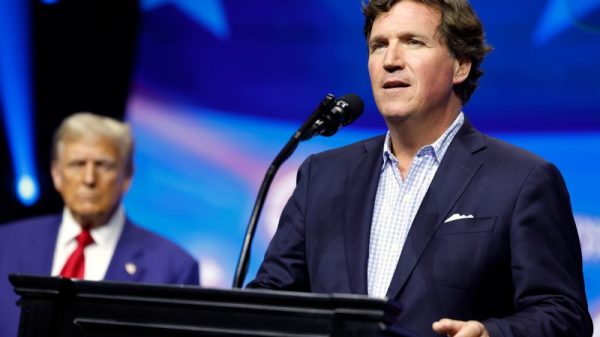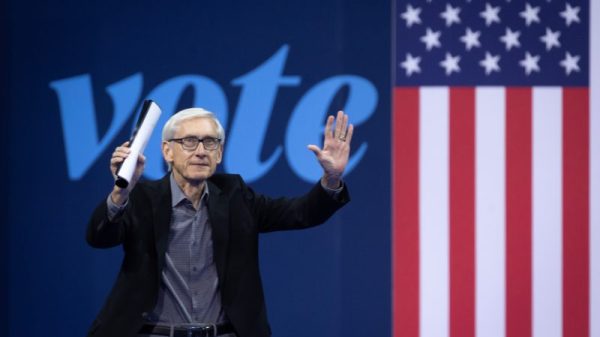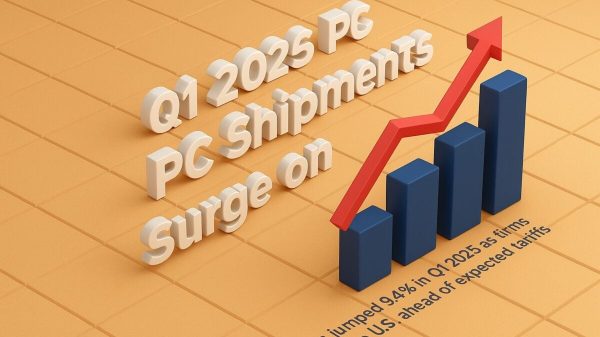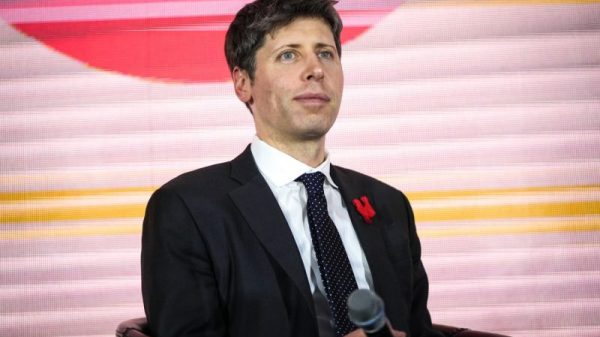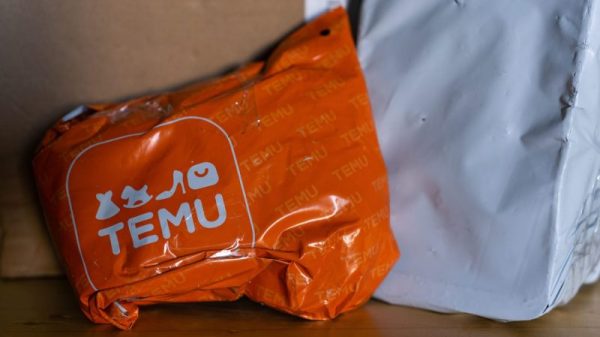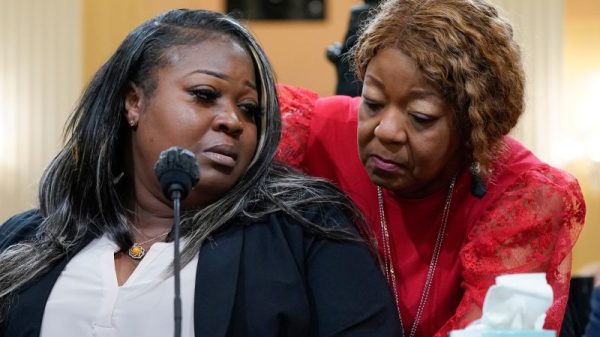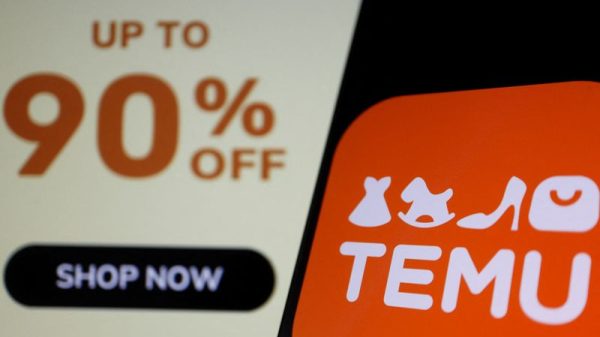National Vision Holdings Inc. (NASDAQ:EYE) reported a modest revenue growth and a strategic shift in their store operations during their Q3 2024 earnings call. The company posted a 2.9% increase in revenues, reaching $451.5 million, and a rise in adjusted operating income to $14.3 million. Adjusted diluted EPS stood at $0.12.
Notably, National Vision announced a plan to close 39 stores by 2026 for an adjusted EBITDA improvement of about $4 million, while slowing down new store openings in 2025 to focus on enhancing customer experience and operational efficiency.
Key Takeaways
National Vision reported a revenue increase of 2.9% to $451.5 million in Q3 2024.
Adjusted operating income rose by 22.2% to $14.3 million; adjusted diluted EPS was $0.12.
The company plans to close 39 stores by 2026, aiming for an adjusted EBITDA improvement of $4 million.
New store growth will be moderated in 2025 with 30-35 new America’s Best stores planned.
Over 730 locations now offer remote exams, accounting for 11% of exams in remote-enabled states during the quarter.
New President Alex Wilkes highlighted the importance of customer experience and operational execution.
Company Outlook
National Vision is committed to transforming operations for long-term success.
Revenue guidance for fiscal 2024 is estimated at $1.82 billion to $1.84 billion.
The focus will be on disciplined growth, primarily under the America’s Best brand, in remote areas.
Strategic initiatives aim to enhance profitability through operational adjustments across the store fleet.
Bearish Highlights
Challenges in e-commerce and weather impacts from Hurricanes Beryl and Helene have been noted.
The company anticipates revenue headwinds due to store closures.
There are concerns about expected headwinds in incentive compensation and the impact of tariffs.
Bullish Highlights
Positive trends in exam capacity and retention rates have been reported.
The company is optimistic about its margin profile for 2025.
Strategic promotions and innovative products like Pair Eyewear are attracting new customers.
Misses
Declines in cash pay and e-commerce revenue were observed.
A slight decline in remote exam penetration compared to Q2 was attributed to digital experience issues.
Q&A Highlights
America’s Best has a low single-digit percentage of dark stores and a high single-digit percentage of dim stores.
Remote exam capabilities are being expanded to mitigate the impact of dark and dim stores.
A 40% discount on second pairs for managed care customers is part of a long-standing strategy to enhance customer value.
National Vision’s Q3 2024 earnings call revealed a company navigating through a mix of challenges and strategic growth opportunities. With a focus on improving customer experience and operational execution, the company is making calculated decisions to close underperforming stores and moderate new store openings. Leadership remains optimistic about the future, citing investments in technology and store improvements as key drivers for long-term success. Investors and stakeholders will be watching closely as National Vision continues to adapt to market conditions and consumer demands.
InvestingPro Insights
National Vision Holdings Inc. (EYE) is navigating a complex financial landscape, as revealed by recent InvestingPro data and tips. The company’s market capitalization stands at $940.48 million, reflecting its position in the optical retail sector. Despite the challenges outlined in the earnings call, InvestingPro Tips indicate that net income is expected to grow this year, aligning with the company’s strategic initiatives to enhance profitability through operational adjustments.
The stock has shown significant volatility, with InvestingPro data reporting a strong return of 15.42% over the last month, but a substantial decline of 33.22% over the past six months. This aligns with the company’s reported mixed performance and ongoing strategic shifts. The recent stock performance could be attributed to investors reacting positively to National Vision’s plans for store closures and focus on operational efficiency.
An InvestingPro Tip suggests that analysts anticipate a sales decline in the current year, which corresponds with the company’s guidance and expected revenue headwinds due to store closures. However, it’s worth noting that National Vision’s revenue for the last twelve months reached $2,164.4 million, with a growth rate of 16.07%, indicating resilience in a challenging market.
For investors seeking a more comprehensive analysis, InvestingPro offers additional tips and metrics that could provide deeper insights into National Vision’s financial health and market position. Currently, there are 11 additional InvestingPro Tips available for EYE, which could offer valuable perspective on the company’s future prospects.
Full transcript – National Vision Holdings Inc (EYE) Q3 2024:
Operator: Good day, and thank you for standing by. Welcome to the National Vision Third Quarter 2024 Earnings Conference Call. At this time, all participants are in a listen-only mode. After the speaker’s presentation, there will be a question-and-answer session. [Operator Instructions] Please be advised that today’s conference is being recorded. I would now like to hand the conference over to your first speaker today, Tamara Gonzalez, Vice President of Investor Relations. Please go ahead.
Tamara Gonzalez: Thank you, and good morning, everyone. Welcome to National Vision’s third quarter 2024 earnings call. Joining me on the call today are Reade Fahs, CEO; Alex Wilkes, President; and Melissa Rasmussen, CFO. Our earnings release issued this morning and the presentation accompanying our call are both available on the Investors section of our website, nationalvision.com. A replay of the audio webcast will be archived in the Investors section after the call. Before we begin, let me remind you that our earnings materials and today’s presentation include forward-looking statements as defined in the Private Securities Litigation Reform Act of 1995. These statements are subject to risks and uncertainties that could cause actual results to differ materially from our expectations and projections. These risks and uncertainties include, but are not limited to, the factors identified in the release and our filings with the Securities and Exchange Commission. The release in today’s presentation also includes certain non-GAAP measures. Reconciliation of these measures is included in our release and the supplemental presentation. We would like to draw your attention to Slide 2 in today’s presentation for additional information about forward-looking statements and non-GAAP measures. Further, please note that all financial measures in today’s commentary are based on a continuing operations basis unless otherwise noted. As a reminder, National Vision provides investor presentations and supplemental materials for investor reference in the Investors section of our website. I will now turn the call over to Reade. Reade?
Reade Fahs: Thank you, Tamara, and good morning, everyone. Thank you for joining us today. I’ll begin with a brief overview of our third quarter results, and will then provide an update on the progress we’re making to accelerate our transformation, including the actions we plan to take as a result of the completion of our store fleet review. First, for the third quarter, revenues increased 2.9% to $451.5 million. Sales were once again driven by strong managed care results, partially offset by softness in cash pay, and lower e-commerce revenue. The trend in managed care strength offsetting performance from cash pay customers, is in line with the trends facing the category, based on recent reports from others in our space, as well as my ongoing discussions with industry leaders. Adjusted comparable store sales were 0.9%, with America’s Best comps at plus 1.2%, and Eyeglass World at a decline of 0.9%. Eyeglass World was trending towards a positive comp quarter, before Hurricane Helene hit. About 30% of Eyeglass World stores are in Florida, and thus the brand was disproportionately affected by the late quarter storm. Adjusted operating income increased 22.2% to $14.3 million. This resulted in adjusted diluted earnings per share of $0.12. Now, I’ll turn to our strategic initiatives and the areas in, which we are accelerating our transformation. This includes the results of the comprehensive review of our store fleet, the implementation of traffic driving initiatives, and our ongoing focus on expanding exam capacity. Last quarter we shared that we were taking a hard look at our store fleet, as our threshold for underperforming stores, has intensified given the current environment. The purpose of this comprehensive review, was to ensure that our real estate investments are meeting higher standards, with the goal of better optimizing profitability for the long-term as this will improve the overall health of the core business. Today, we announced the results of this review, sharing that we plan to close 39 stores through 2026. This includes 21 America’s Best stores, nine Eyeglass World stores and nine Fred Meyer stores. As a result, we expect to deliver approximately $4 million in adjusted EBITDA improvement, by the end of 2026. We are grateful to the associates and affiliated optometrists in the affected stores, and are working to maximize their transition to other stores where possible. We are also committed to ensuring that there is a seamless transition, for the patients and customers who rely on us. As part of our review, we also identified four Eyeglass World stores that we plan to convert to America’s Best by the end of 2024. These stores are all in the Detroit market, which America’s Best has been in for 38 years, and thus has significant brand recognition. Finally, we announced today that, we are temporarily moderating new store growth in 2025. We plan to open between 30 and 35 new America’s Best stores next year essentially all in remote enabled states. Taken together, the store closures and moderating new store growth next year, provide us with the capital and dedicated time, to focus on improving the patient and customer experience, and operational execution in our current base of stores. We are being intentional in taking this time to strengthen our comp base, and plan to reaccelerate our new store growth plans towards our more recent opening cadence, as our strategies begin to take hold, with a renewed focus on profitable growth. Our white space opportunity for growth is significant, as we shared with you earlier this year, our total opportunity is more than double our existing store count, with at least 2,500 total stores across our brands. Turning next to our initiatives that are focused on driving traffic through new promotions, exciting new product launches and expanding optometric capacity. This summer we introduced our new Wise (LON:WISEa) Buys promotion at America’s Best, to attract more customers via enhanced value perception messaging. We were especially pleased with the results from America’s Best first ever progressives offer of two pairs for $129.95, which includes an eye exam. Following this promotion, we’ve introduced a new entry progressive bundled offer that provides an ongoing everyday value. We continue to see both promotion, and price as viable levers in our ongoing transformation. When it comes to price, we offer a very attractive value proposition to our customers. We will continue to evaluate all aspects of our pricing relative to our position within our category, to ensure that our value offering remains compelling to our customers, while also balancing the impact of cost inflation. In the area of product mid quarter, we launched the Florence by Mills eyewear collection by Stranger Things star Millie Bobby Brown in our America’s Best and Eyeglass World stores. As the exclusive retail partner in the U.S., we are able to provide our value seeking customers, with a fashionable and affordable selection that is tied to a popular celebrity. And at the end of the quarter, we launched our exclusive partnership with Pair Eyewear nationwide at America’s Best. Pair Eyewear is a leading customizable, stylish and accessible eyewear brand that, has to-date only been offered online and is generating a lot of excitement. It involves a base frame, with a variety of magnetic top frames that allow customers, to easily customize their look and style. We’ve created an innovative personalized shopping experience, with a store within a store concept where customers can try on a variety of swappable top frames. This is a win-win partnership. Pair gets access to doctors and store infrastructure, and we get to be the exclusive brick and mortar provider of a unique online brand, experiencing strong customer interest. We have high hopes for what this can mean in terms of generating consumer excitement, for this historically online only brand, and what it can mean to enhancing our fashion credibility with younger audiences. Lastly, with respect to our efforts in expanding exam capacity, we continue to leverage our remote capabilities, to expand exam capacity. As our remote technology solution continues to advance, we are better able to address capacity issues across our fleet, as well as provide doctors with convenient new ways to practice. We now have over 730 locations, enabled with remote technology. Remote exams represented about 11% of exams in remote enabled states, for the quarter. Encouragingly, this quarter remote doctors’ patient seen per day exceeded that of in-store doctors for the first time. We also recently expanded our hybrid remote pilot to 16 stores. Recall this involves optometrists in stores remotely performing exams in other stores, based on availability and demand. We have high hopes for the systemic enhancements this approach could potentially generate, to see more patients. We believe our remote program is still in early innings, and there continues to be significant opportunity and expected benefits. We remain pleased with our previously announced decision, to add incremental late day appointments. We want to be there for our customers who, are ever more returning to traditional working hours. Our optometrist retention levels remain in line with our historical range, of 80 to 90%. During the quarter, we saw the lowest OD’s resignations in Q3 since 2020. On the recruitment front, we are taking a number of steps to enhance recruiting success, providing additional support to those studying for their board exams, while also strengthening our internal recruiting team and its resources. Overall, we’re making progress against our initiatives, and we remain on track with our objectives for this year. As noted with our reiteration of guidance. I want to thank all of our teams for their ongoing execution and commitment, as we accelerate the pace of change across the organization. I could not be happier with the two new leaders who joined us late this summer, and have hit the ground running bringing fresh perspectives and insights to our teams. Before Melissa covers our financial results and outlook, I would like to share some perspectives on how our business has been reinvigorated, by the fresh perspectives brought by our newly appointed President, and our new Chief of Stores. They are leading a reexamination of our operational elements that directly impact the patients and customers. In the process, we’ve taken a hard look at our operations, to uncover areas that directly impact the patient and customer experience across operations, merchandising, marketing and managed care. Some examples of areas we are improving include consultative selling, modernizing the examined shopping experience, more personalized marketing, and enhancing the product assortment. I’m optimistic as I have already seen the excitement from our field leadership, in response to these new ideas, and from our stores to the initial rollout of the first few of them. These are specific areas we can improve that are within our control, each of which we believe will drive higher revenues, and increase profitability. I’d like to now turn the call over to Alex Wilkes, who was recently appointed National Vision’s President. He and I have been working side-by-side, for the past 2.5 months. With experience with major frame, lens and contact lens suppliers, as well as the important leadership roles he played with competitors. Alex has a unique collection of reference points, to help guide our ongoing transformation efforts. And with that, I’d like to introduce Alex and let him say a few words, before we turn the call over to Melissa. Alex?
Alex Wilkes: Thanks Reade. Appreciate the warm welcome. During my time in the optical industry, I’ve had the privilege to observe National Vision from up close. I’ve always been impressed by the phenomenal growth of the company, the special culture within the stores, and the strength of the brands. I’m privileged to join the organization during this transformational moment, and play a role in defining the next chapter of growth for the company. Over the last several weeks, I’ve spent a lot of time in stores, with our associates and doctors. I’ve come away from these experiences thoroughly impressed. Our associates and field leaders, have an incredible sense of pride in their affiliation with the company, and our network of doctors, and overall eye exam experience is second to none. The investments made in the exam experience, including our remote capabilities, are a true differentiator for us and a delighter for our patients and customers. I’ve also been deeply engaged with our management team, reviewing our strategic approach to evolving the organization. We’re taking a hard look at all aspects of demand generation and cost efficiency. As Reade mentioned, we have learned quite a bit from the promotional actions we took in the quarter. We are assessing our near and long-term plans, regarding price architecture and price evolution, and are taking significant steps towards enhancing how our customers experience us, both digitally and in-store. In the second half of 2025, we are on target to go live with a new CRM platform that will help further modernize our marketing efforts, allowing us to reach our customers with personalized messages, based on data driven insights. These customer journeys will allow us to engage, and reactivate customers with one-to-one messages and to drive retention, and basket size via tailored offers. We are also making substantial investments in our merchandising capabilities, ticking off just this week this important merchandising phase of our ERP project. Once implemented, among other things, this will provide us enhanced regional assortment and pricing capabilities, unlocking the ability to serve our customers products, most relevant to their specific segment. These are just a few of the breakthrough programs, we are currently working on to modernize our business. I am confident, we will accelerate our growth. I joined National Vision, with a mandate to drive transformation and accelerate our change agenda, so I couldn’t be more pleased with the widespread openness, to new approaches and the sense of urgency the team has shown. We will be sharing our transformation game plan in more detail over the coming quarters, a plan that leverages the company’s historical strengths while embracing new ideas, and ways of working to deliver on our growth and profit aspirations. And with that, I’ll turn it over to Melissa.
Melissa Rasmussen: Thank you, Alex, and good morning everyone. As discussed, our third quarter results reflect trends consistent with what we have seen throughout the year, with growth in our America’s Best brand supported by ongoing strength in our managed care business, which has helped to offset the softness in our cash pay consumer. For the third quarter, net revenue increased 2.9%, compared to the prior year period, driven by new stores adjusted comparable store sales growth, and the effect of unearned revenue, partially offset by the effect of converted and closed stores, and lower e-commerce revenues. Unit growth in our America’s Best in Eyeglass World brands, increased 5.4% on a combined basis, over the total store base last year, and we ended the quarter with 1,231 stores. With respect to e-commerce, performance in the quarter was impacted by the transition of the discountcontacts.com website. As a reminder, this was the one website previously operated by AC Lens that we retained under the National Vision umbrella. During the transition, certain website features, and associated marketing were temporarily disrupted, which we believe were the primary drivers of the decline in performance during the quarter. We have since restored marketing plans, and expect key website features to be fully restored, during the first quarter of 2025. Given these results are recorded in our Corporate Others segment, they do not impact our adjusted comparable store sales growth. Adjusted comparable store sales growth for the quarter was 0.9%, and included approximately a 50 basis point headwind related to the severe weather we experienced during the period due to Hurricanes Beryl and Helene. Our adjusted comparable store sales growth, was driven by an increase in average ticket of 1.3%, and a 0.1% increase in customer transactions. Given the promotional activity during the quarter, I wanted to provide a little more color on our traffic and ticket trends. Third quarter promotions focused on America’s Best Eyeglass purchases, driving a low-single-digit increase in eyeglass transactions, which more than offset the decline in ticket in that category. As a percentage of net revenue, costs applicable to revenue increased approximately 20 basis points, compared to the prior year quarter. This resulted in a gross margin decrease of approximately 20 basis points, driven primarily by an increase in optometrist related costs, which was almost fully offset by higher exam revenue, supported by pricing actions and growth in exam count. Adjusted SG&A expense as a percentage of revenue decreased 60 basis points, compared with the third quarter of 2023. The decrease in adjusted SG&A, as a percentage of net revenue was driven primarily, by a decrease in performance based incentive compensation of approximately 80 basis points, and other operating expenses partially offset, by higher store payroll and occupancy expenses. Depreciation and amortization expense was $22.7 million, compared to $22.5 million in the prior year period. Adjusted operating income was $14.3 million, compared to $11.7 million and adjusted operating margin increased approximately 50 basis points to 3.2%, compared to the prior year period, due primarily to the factors previously discussed. Net interest expense was $4.1 million, compared to $3.7 million in the prior year period. As a reminder, our interest guidance excludes non-cash, mark-to-market and deferred financing costs, which totaled $1.1 million. Adjusting for this interest expense was $3 million. Adjusted diluted EPS increased to $0.12 per share in the third quarter of fiscal 2024, from $0.11 per share a year ago, and reflects an effective tax rate of approximately 18.9%. Turning to our year-to-date financial results. On a continuing basis, net revenue increased approximately 3.8%, driven by growth from new store sales adjusted comparable store sales growth, and the effect of unearned revenue, partially offset by the effect of converted, and closed stores and lower e-commerce revenue. Adjusted operating margin increased 30 basis points, compared to the prior year period, driven primarily by the same factors, which impacted the third quarter that I just reviewed. Please see our press release for detailed reconciliations, of our quarter and year-to-date adjusted results, to the most comparable GAAP measures. Turning next to our balance sheet, we ended the quarter with a cash balance of approximately $81.2 million, and total liquidity of $374.8 million including available capacity, from our revolving credit facility. As of the end of the quarter, our total debt outstanding was $353.8 million net of unamortized discount, and for the trailing 12 months, net debt to adjusted EBITDA was 1.8 times. As announced in August, we repurchased $218 million of our outstanding convertible senior notes for an aggregate cash repurchase price of $215 million. This transaction was funded with cash of $100 million, and incremental Term Loan A borrowing of $115 million. After the repurchase, approximately $85 million of convertible senior notes remain outstanding. Upon maturity in May of 2025, we expect to settle with cash or borrowing on our revolving credit facility. We continue to maintain a strong balance sheet and a healthy cash flow, to support our growth and capital allocation priorities. Year-to-date, we generated operating cash flow of $103.4 million and invested $63.5 million in capital expenditures, primarily focused on new and existing stores, and investments in remote technology. We have revised our expectations for capital expenditures for the year, and now expect CapEx to be approximately $100 million to $105 million. With respect to the rest of our fiscal 2024 outlook for continuing operations, as detailed in our press release, we are reiterating our expectations, including revenue, to be in the range of $1.82 billion to $1.84 billion, based on an adjusted comparable store sales growth range of 0.5% to 1.5%. Adjusted operating income to be in the range of $57 million to $62 million; and for adjusted diluted EPS to be in the range of $0.45 per share to $0.50 per share. As we have previously discussed, our guidance ranges consider a variety of scenarios. The midpoint of our adjusted comparable sales guidance range, typically reflects expected results more in line with our current trends, while the top and bottom point reflects opportunity, and certain levels of risk given contemplated variables. As many have discussed, this year has seen continued inconsistency, with respect to consumer behavior. This continues to be the case as we look to fourth quarter. We saw a choppy start to the quarter with Hurricane Helene. However, our teams remain committed and focused on executing and driving results, especially as we head into the peak volume week of the quarter, which drove strong performance last year. Our outlook for the remainder of the year, does not expect a material impact from the expected fiscal 2024 closures, or the Eyeglass World conversions as a result of our store fleet review. As we discussed, following the completion of our store fleet review, we plan to convert four Eyeglass World stores in fourth quarter to America’s Best stores, and plan to close 21 America’s Best stores, nine Eyeglass World stores and nine Fred Meyer stores, by end of fiscal 2026. We expect these closures to deliver approximately $4 million in adjusted EBITDA improvement, by the end of fiscal 2026 despite a $13 million to $16 million expected revenue headwind, as we have conservatively assumed no revenue recapture from other locations. As detailed in our press release this morning, the majority of the impact from both an adjusted EBITDA improvement and revenue headwind perspective, will be reflected in fiscal 2025. During the quarter, we recorded approximately $1 million of one-time non-recurring exit charges related to the fiscal 2024 and fiscal 2025 closures, and $14 million in non-cash impairment charges related to the Fred Meyer intangible asset, into other tangible long-lived assets. We plan to continue to closely monitor store performance, and store profitability as part of our ongoing real estate portfolio strategy to maximize returns. As a reminder, through this comprehensive review, less than 5% of our fleet was identified as not meeting our higher standards given the current environment. We are committed to maintaining a healthy store fleet, while focusing on driving improved comparable store sales growth. With this in mind, we have made the decision to temporarily moderate our store growth plans for fiscal 2025, and plan to open between 30 and 35 new stores next year. This will enable us to allocate capital, to increase investments in enhancing the overall patient and customer experience, such as modernizing the exam and shopping experience. We believe through this enhanced focus on our current fleet, we will receive a greater return on investment, through improving adjusted comparable store sales performance, which will drive greater leverage in the operating model and overall profitability. As performance improves, with initiatives gaining traction, we intend to reaccelerate our new store openings, to our more recent store opening cadence, with a commitment to disciplined growth given the significant white space opportunity still in front of us. We believe the actions we are taking today, will not only help stabilize our comp performance, but will strengthen our foundation as we continue to position National Vision for long-term success. Thank you for your time today. I will now turn the call over to Reade for closing remarks, before we open the call for questions. Reade?
Reade Fahs: Thank you, Melissa. The energy and excitement here is strong, with the team driving fresh ideas and observations, thanks to the fresh perspective across all aspects of our business brought by new additions to our leadership team. We tried new promotions that brought in new customers, and resulted in changes to our everyday offering. We launched exclusive, innovative new products, most notably Pair Eyewear. We improved the efficiency of our remote program, and expanded the trial that could result in a real systemic improvement, with ODs in less busy stores performing exams remotely in busier stores. And the store closures stemming from our fleet review, along with temporarily moderating new store growth in fiscal 2025, together provide us with the capital and resources, to devote to improving the patient and customer experience in our current stores, along with renewed focus on operational execution. We are committed to transforming our business, and are taking a hard look at all aspects of demand generation and cost efficiency, with an improved and differentiated patient and customer experience. And we believe we will emerge as a stronger business, by taking next year to refocus on our comp base of stores. The organization is excited by and rallying around the transformation, and we believe it will drive shareholder value. Thank you for your interest in National Vision. Operator, we will now open the call for questions.
Operator: Thank you. [Operator Instructions] The first question comes from the line of Michael Lasser of UBS. Your line is now open.
Michael Lasser: Good morning. Thank you so much for taking my question. So it seems like the business is experiencing a stabilization phase. You’re making a bunch of changes, including to the store portfolio, the pricing architecture, some of the operational processes. If you could tie this all together, and give us a sense of what that means for the margin profile of the business in 2025, it will be extremely helpful?
Melissa Rasmussen: Hi Michael. Good morning. Thank you. Yes. As far as the 2025 margin profile, what we had talked about last quarter was that we had anticipated that the ’25 margin profile would look similar to what we were going to end ’24 at. Now what that specifically contemplated when we spoke to that, was it contemplated the headwind that we talked about related to incentive compensation because it’s been a tailwind this year, and we expect that to turn into a headwind next year. We also expected some benefits from our fleet optimization. While we were still undergoing that exercise and didn’t know the exact amount, we did anticipate a level of benefit from that. Now what we did not incorporate into that statement was everything that we spoke about today. So it doesn’t contemplate the moderation in-store growth as well as the initiatives that we plan to focus on, that we’re expecting to help drive some comparable store sales growth and overall improve the stability of the fleet.
Michael Lasser: Most I would suppose you want to frame what that – what all these actions that you announced to-date could mean?
Melissa Rasmussen: Yes, sure. So the way that we were looking at that is we expect this investment in our overall store fleet to drive some improvement in the top line. We’re expecting to see the modernization of our stores. We’re expecting to see some patient and customer improvement in the overall experience. And that was going to come through a couple of different paths. We were expecting to put some investment into our overall fleet, including e-commerce, so that it more closely modeled the journey of our in-store experience as well as the digitization in tools that we expect to give to our sales associates to help facilitate more modernized selling experience. And the flat view essentially is the base case. That’s what we spoke to last quarter. I would expect that this updated discussion will include more of an upside. It will, of course, provide some incremental information on that as we release our ’25 guidance.
Michael Lasser: Okay. That’s very helpful. My follow-up question is on pricing. It seems like National Vision, is more willing to exercise the use and muscle of price more so than it has been in the past. It’s finding areas where there’s inelasticity in its assortment, and amongst its customer set. So a, is that true? And b, you probably saw there was an election last night. So to what degree is this going to help as you navigate what should be through — what could be a tariff environment? And how exposed are you to tariffs from not only China, but overseas in general? Thank you very much.
Reade Fahs: Thank you for that. As we’ve been mentioning, we’ve brought in 2 new leaders with some really fresh perspectives. And Alex Wilkes has the industry experience, but from other parts of the industry with different dynamics. Alex, why don’t you sort of take the first piece of that?
Alex Wilkes: Sure. Hi. Good morning, Michael. So first and foremost, I’d say we’re committed as our – to our position of being a value-based brand. However, we certainly do see that there’s opportunity to expand pricing balancing both our pricing and our promotional approach. So certainly, we’re going to look for ways to do that. And also considering the impact of inflation going forward. Now I think one of the interesting things about our company is that historically, our pricing has been architected around the cash pay customer. And as the team has spoken of over the past few quarters, we’ve seen our managed care consumer base grow substantially. So with that in mind, that does require us taking a different look, because to your point, we do know there are different elasticities, between a managed care and a cash-based consumer, and we certainly have opportunities to adjust our pricing, as we’ve evolved towards the managed care consumer.
Reade Fahs: And Alex’s experiences with a retailer with a much higher managed care percentage than we have, and it’s been a really great perspective to hear to have that brought to our business, too. Now Melissa, would you like to take the tariff question?
Melissa Rasmussen: Sure. I’ll take the tariff question. So Michael, with the election results coming in, where they did, we don’t quite, at this point, know what the tariff impact is going to be with the new administration. However, based on what was enacted last time, we don’t expect it to materially affect our financial statements. Less than 10% of our costs applicable to revenue are subject to the tariffs that were in place the last time. And we’ve even made more progress at moving more and more activity out of China. We no longer have a lab in China and 90% of our private label has already been moved out of China, and we expect to continue to progress that over 2025. And private label, just for your reference, is about 54% of our business.
Michael Lasser: Super helpful. Thank you so much and good luck.
Melissa Rasmussen: Thanks, Michael.
Operator: Thank you. Our next question comes from the line of Kate McShane of Goldman Sachs. Your line is now open.
Kate McShane: Hi, good morning. Thanks for taking our question. I wanted to drill down a little bit more on your commentary around promotions. Can you talk about how you are viewing them for the future? What are some of the bigger learnings and how it impacted gross margins in the quarter?
Reade Fahs: Thank you, Kate. Yes, well, promotions are something we’re getting good learning on. We’ve been trying a couple of them in the past few years. We were pretty pleased with the learnings, especially on the progressive offer that we have. And we thought that worked so well in driving new progressive customers who are great customers to have that we implemented an ongoing promotion offer into America’s Best even in non-promotional periods. So that’s live and going now. These are good at driving in new traffic, and we would expect to continue with promotions in the future, targeting, of course, the cash pay customer.
Melissa Rasmussen: Kate, I’ll add on the gross margin question that you had. The promotions, of course, every time you offer a promotion, it does have an impact to gross margin. The specific promotions that we were putting in place during the third quarter drove an increase in traffic overall. And that increase in traffic more than offset the impact that those promotions created for the gross margin.
Kate McShane: And then a follow-up question is just about the remote capabilities. What the cadence of rollout remains for this year and into 2025. And is there any way to quantify the lift that you saw in the quarter from the remote exams?
Reade Fahs: So thank you, Kate. So we have 730 remote-enabled stores. We’ve probably got a couple of dozen that we’re going to do by the end of the year, and we haven’t formalized yet the number of stores that we’ll be doing next year. And of course, we continue to watch as states open up to remote. Also mentioned it’s about 11% of exams in enabled states and that we’re pretty excited. While it’s still in the early stages by the possibilities of hybrid remote in that it just, is such a systemic improvement in overall efficiency, to have a doctor live in a store who if they get a cancellation or it’s a slow part of the afternoon, they can pick up exams to any place else in the state. And Texas continues to be encouraging, and we’re pleased with that along the way.
Kate McShane: Thank you.
Operator: Thank you. Our next question comes from the line of Zachary Fadem of Wells Fargo (NYSE:WFC). Your line is now open.
Zachary Fadem: Hi, good morning. So now that you’re a ways through your exam capacity investments, curious what KPIs you can share around how much you’ve increased exam capacity across the fleet this year? And then how your capacity utilization has trended through the year as you’ve stepped up the number of appointments?
Reade Fahs: Yes. So again, we are expanded and it has been nice in terms of improving capacity along the way. So we’re pleased with how that’s going and with it continued potential along the way. And it’s all about it creates new slots. We don’t report out our utilization. But it is giving us incremental average exams per day, and that is helpful. And we’re pleased that combined with that, we’re also seeing sort of Q3 was a great quarter for retention, because you’re trying to balance live and remote. And in terms of – we had less people resigned in Q3, than in the other Q3 in the past several years. So that was another encouraging signal.
Zachary Fadem: Got it. And then with respect to the strategic review, is there any color that you can provide on regions, demographics or vintages of the stores slated to be closed? And as you reduce the openings in 2025, just curious how you came to this conclusion based on the results of the review?
Melissa Rasmussen: Sure, Zach. As we went through the review, each specific store had individual characteristics that were evaluated that were specific to that store. Overall, the overwhelming majority of our stores are profitable. This exercise targeted less than 5% of our fleet. And out of that, we’re taking action on 43 stores, including closing 39 and converting four of them to – from Eyeglass World to America’s Best. Some of those were dark. Some of those were dim. Some of them have doctors but not the appropriate level of demand that we needed to see to drive the profitability that we needed in that specific store. So as we evaluated the overall profitability, including the lease expiration dates, we made decisions on whether it made sense to make operational improvements or whether it makes sense to exit the stores. There were different vintages across the board, so we can’t say that it was specifically tied to stores opened in one year versus another or older stores versus newer stores. And so, as we went through the exercise, we paid very close attention to cost to exit versus what the overall loss was and made appropriate decisions.
Zachary Fadem: Got it. That’s helpful. Thanks, Melissa. Appreciate the time.
Melissa Rasmussen: Thank you.
Operator: Thank you. Our next question comes from the line of Simeon Siegel of BMO Capital Markets. Your line is now open.
Jon Elias: This is Jon Elias on for Simeon. On the store fleet review and the $4 million EBITDA opportunity there, just to clarify, did those stores collectively lose $4 million of EBITDA? Or does that number contemplate improvements beyond the closures?
Melissa Rasmussen: Yes. So the $4 million figure that we put out did equate to the luck that we were seeing from those individual stores. Now the $4 million that we are expecting to receive an EBITDA benefit on, that’s split across the years that we spoke to. So two to three of that is expected to be realized in 2025, and the remainder of which will be recognized in ’26.
Jon Elias: Great. And then for my follow-up, as we think about the remaining stores not impacted by the closures, can you give us a sense of what the margins look like for your top-performing store cohorts versus the bottom? Thank you.
Melissa Rasmussen: Yes. But as far as our overall fleet performance, we have top performers and we have performers that we need to pay close attention to, to make sure that we can make operational adjustments. As we continue to evaluate the overall fleet, we will strive to improve operating margins for the entire fleet as a whole. The ones that we did close were, in fact, unprofitable and taking that out will, of course, improve the overall performance of the fleet.
Jon Elias: Thank you. And all the best.
Melissa Rasmussen: Thank you.
Operator: Thank you. Our next question comes from the line of Simeon Gutman of Morgan Stanley (NYSE:MS). Your line is now open.
Unidentified Analyst: Hi. This is [Lauren] on for Simeon. My first question is just on consumer demand and the overall macro. I guess the reiterated ’24 comp guidance at the midpoint does imply Q4 comp acceleration, both on two and five-year stocks. I guess could you provide us any more details on what the low end and high end of the comp guidance contemplates? Thank you.
Melissa Rasmussen: Sure. The midpoint of the comp definitely anticipate in-line results with where we are currently. We did see a start of the quarter where we had a choppy start because of Hurricane Helene, and we did talk to the shorter selling season at the end of the year, which is our peak week for the fourth quarter. That being said, as we’ve talked previously, the high end of the guidance would typically incorporate an improvement in macro overall as well as some of the initiatives that we’ve spoken to taking hold. The low end would be a deterioration in overall macro, and less traction from the initiatives that we’re putting in place.
Unidentified Analyst: Got it. That’s helpful. And then my second question is just on SG&A. It appears the business has been able to generate some nice leverage on year-to-date. I guess looking forward, curious to see how this plays out in Q4 and perhaps into ’25. I think you mentioned the incentive comp could be a headwind in ’25, but just other factors at play would be helpful? Thank you.
Melissa Rasmussen: Yes. So with SG&A, the incentive compensation component is by far the large component driving SG&A. We have seen a tailwind for the entire year based on the lower levels of incentive compensation at payment based on overall performance of the company. That said, with that tailwind that we’re seeing this year, we’re also seeing some offsetting headwinds in payroll and occupancy that we spoke to in our prepared remarks. Now moving into ’25, we’ll, of course, provide a full guidance when we announce our fourth quarter results, but I would certainly anticipate that we’ll see a headwind associated with the instead of compensation that we’ve already talked to.
Operator: Thank you. Our next question comes from the line of Dylan Carden of William Blair. Your line is now open.
Dylan Carden: Thanks. I just have two here. One, it appears that we just aren’t seeing a repurchase cycle here, now about three years into the last major uptick. And I’m just curious, if this is a two to four-year repurchase product, what you make of that? And kind of any visibility you have into when that might correct if that is indeed correct?
Reade Fahs: Yes. So Dylan, again, the Managed Care segment is quite healthy but our demand trends relative to the cash pay customer remain similar. They have not shown a rebound yet. And — but we’re not waiting for the purchase cycle to come back. We’ve got a lot of things in our toolkit that we can control on our own, and we are driving towards those. And again, as I said, we’ve got a lot of fresh perspectives that we’re putting to bear in our transformation. We are going about sort of improving the comp base. We’re making investments to do that and to drive profitable growth. And I think you’re going to be seeing ever more of that. I’m a little hopeful that maybe with the election behind us, there will be a little bit more consumer confidence and less uncertainty, but you never know in this world.
Dylan Carden: Okay. And I’m just confused here on the messaging on the pricing. It seems like you’re ever willing to look at price across your offering, maybe break it down by managed versus cash. But then you were extremely promotional in the period as you kind of acknowledged. And so I’m just – didn’t see much of a complex as a result of that. So I’m just – can you just kind of boil down – are you thinking about taking more price here? Do you think about being more promotional? Where are you on kind of the price discussion at this point?
Reade Fahs: We’re looking at the two in, two together, price and promotion. So when we’re talking about our price architecture, we can talk about our price and promotion architecture, we’re seeing that managed care customers approach this differently. I mean we know that, but we are approaching this differently, and are looking for a variety of different things and approaches. And as we are launching new products, we have that in mind. And where we see the promotional piece, is very targeted towards cash pay customers.
Dylan Carden: So net-net, does that leave you in the same place, I guess, is the question?
Reade Fahs: No. I think we believe that we can expand our price, and take pricing and use it as a lever ever more in the future.
Dylan Carden: Excellent. Thank you.
Operator: Our next question comes from the line of Paul Lejuez of Citi. Your line is now open.
Paul Lejuez: Hi, thanks guys. Can you talk about the stores that you are opening next year? Are they concentrated in any particular region? Are you changing anything about those stores that you will continue to open? And then second, with the lower store growth, curious what CapEx might look like next year? And just how we should think about CapEx even beyond next year? Thanks.
Reade Fahs: Thank you very much. We are focused on remote states only. So that way we know we can always have a doctor available, and we’re only focused on America’s Best now. And so while we stabilize when we go about stabilizing Eyeglass World, we think of this as a very disciplined growth.
Melissa Rasmussen: Yes. And related to the CapEx question, Paul, we are anticipating that with the moderation in store growth, we will be reinvesting in our store fleet. Now some of that will come in the form of CapEx. Some of that will come in the form of cloud. And some of that will also come in the form of operating expense. Now as far as the operating expense increase is tied to some of these initiatives that we’ve spoken to today, we expect that, that’s going to generate more than an offset in the top line. So it shouldn’t be an impact to profitability.
Paul Lejuez: So should we assume that CapEx levels sort of hold the same next year as this year?
Melissa Rasmussen: We’ll provide more details on CapEx as we do our ’25 guidance. But like I said, I would expect some moderation in CapEx from the perspective as we’re reallocating our capital to these other buckets as well. So some of it will be CapEx. Some of it will be cloud and some of it will be operating.
Paul Lejuez: Yes. Thanks. Reade, just another one. Just are there any opportunities out there to operate optical units within another retailer, maybe something you couldn’t have previously pursued because of the Walmart (NYSE:WMT) relationship? Anything like that that you would consider?
Reade Fahs: There are always opportunities, and we evaluate a variety of different things. Nothing immediately on the horizon, but we talk to everyone and look at a variety of different options. We know how to do a host. We’re still doing a host in our Military and Fred Meyer area. But we frankly do. We are focused on transforming the America’s Best brand. That is our primary focus right now.
Paul Lejuez: Thank you. Good luck.
Operator: Thank you. Our next question comes from the line of Brian Tanquilut of Jefferies. Your line is now open.
Brian Tanquilut: Hi, good morning. Maybe just a question. As I think about the store rationalization that you announced, and it seems like these are your unprofitable stores and military, it sounds like you ran a filter to figure out the exit cost as well. But as we think about kind of like the go-forward strategy, I mean, is there a look on like returns metrics on return on invested capital to these stores or maybe raising the bar, on the profitability threshold versus just breakeven?
Melissa Rasmussen: Hi Brian, yes, as we’ve looked through this store rationalization, of course, the goal is to have the highest profit margin as we can. However, that being said, there are different factors to consider for each individual store. When we talk through the filters that we were looking at as far as the store closures and the profitability associated with those, there are also differences in the stores have remained open. There are different by brand. There are differences by doctor model. Some stores have one lane, some stores have two lanes. And so the overall 4-wall impact is different by the type of model. And so as we look at that, we’ll continue to make sure that we make the right operational changes for each individual store to keep them healthy and profitable.
Brian Tanquilut: Got it. Thank you.
Operator: Thank you. Our next question comes from the line of Adrienne Yih of Barclays (LON:BARC). Your line is now open.
Adrienne Yih: Thank you very much and thanks for all the color. Reade, I was wondering if you can talk about the target 2,500 potential stores across all brands. How should we think about that? Obviously, mostly America’s Best. And then maybe a metric such as how many MSAs or DSAs have maybe one store and what percent maybe of two stores? So what does the fill-in look like? Secondarily, a lower rate environment kind of as the Fed potentially continues to cut. How has your customer reacted in the past in such an environment on sort of like demand – the demand curve, the outward demand curve? Thank you so much.
Reade Fahs: Thank you, Adrienne. We do not see the recent actions as impacting our white space. We closed less than 3% of our stores which we just consider sort of a good hygiene along the way. And so as we see our comp base improving in more profitable ways than — and our efforts taking root that we see returning to more recent store growth trend levels. And we’re pleased that the vast majority of stores in the white space that we’ve got there are in remote – currently remote-approved market. So that’s a plus for us also in terms of dealing with the optometric shortages out there because remote, of course, is so efficient. In terms of the lower interest rate environment, well, that has to be good for our consumers. So yes, as rates go down, we see that, that should be – provide some relief to the cash pay segment of our business.
Adrienne Yih: Okay. Great. And then just a quick follow-up for Melissa. As we think about kind of maybe possibly the shaping of 2025, how should we think about sort of SG&A dollar growth net of the closures, and just like the core continuing ops business? And Reade, one final one for you. The trade-down effect, are you still seeing that in your income cohorts? Or has that stabilized?
Melissa Rasmussen: Sure, Adrienne. As far as the overall SG&A, again, I’ll provide a full 2025 guidance when we release our fourth quarter results. We do anticipate that we will certainly have a headwind related to the incentive compensation reset. As we talked about in this quarter, we saw a tailwind of 80 basis points related to incentive compensation. Again, I would expect similar levels of that as we roll into 2025 as far as a headwind, and we’ll again provide more detail on that as we release our ’25 guidance.
Reade Fahs: And to the other part of your question, the trade down is not — it’s not dramatically different than what it’s been. Again, the big trend is more managed care and software cash pay, and we’re hearing that from various aspects of the industry.
Adrienne Yih: Great. Thank you very much.
Reade Fahs: We do find that we think this is a very sticky piece having – once people try us, they like our value. And we think we’re providing good value to everyone, whether it be cash pay or managed care. I think the managed care folks are saying, Well, our managed care money goes a lot further over at America’s Best and Eyeglass World.
Adrienne Yih: Great. Thank you very much.
Operator: Thank you. [Operator Instructions] Our next question comes from the line of Molly Baum of Bank of America. Your line is now open.
Molly Baum: Hi, thanks so much for putting me in here. I just had two follow-up questions based on some of your questions that have been asked. So the first one I wanted to follow up on is just on optometrist capacity. So I’m curious if you can give an update maybe the percentage of dark and dim stores you’re seeing at America’s Best or if you have any numbers to give on Eyeglass World. I’m curious how remote expansion is offsetting maybe other trends you’re seeing. I know last quarter, you talked about the lower-than-expected results from the optometrist recruitment class. So maybe just additional color on the dark and dim stores, if you can provide it and how those trends are maybe offsetting each other?
Melissa Rasmussen: Hi Molly. Yes. Related to the overall capacity with dark and dim stores, we have continued to see about the same levels of dark and dim stores. The America’s Best fleet has a low single-digit range of dark stores and a high single-digit range of dim stores. We haven’t spoken previously to Eyeglass World. But the remote – or I’m sorry, the dark and dim impacts America’s Best disproportionately because of the size of the fleet. Now remote does offset those dark and dim stores, so that’s the lever that we continue to pull as we enable more and more stores.
Reade Fahs: Right. And I’d just like to add to that also, we are starting to put our remote system into everywhere Eyeglass World stores also to provide the sort of benefit that we’ve been getting from America’s Best.
Molly Baum: Got it. That makes a lot of sense. That’s helpful. Maybe quickly a follow-up to that. I think the penetration of remote exams and remote-enabled stores was down slightly versus 2Q. Is that de minimis? Is it mostly seasonal stoppage?
Reade Fahs: If you look at CrowdStrike (NASDAQ:CRWD) and one or two other tech-related issues, I think that’s really the primary part of that. It’s a digital experience, the remote exam and things like CrowdStrike and can affect this, yes. So think of it as de minimis.
Molly Baum: Got it. Okay. I just wanted to make sure. And then 1 other follow-up question I had is just a little more clarification and color on where promotions are focused because we did a store visit, and noticed that there were some promotions in store targeting, managed care customers. I think it was 40% off your second pair, but I think comments on the call have suggested that promotions are maybe more targeted to the cash customers. So if there’s just any additional color, you can give on the strategy around pricing and promotion for managed care as well?
Reade Fahs: So thank you and good notice on your store visit there. The managed care generally pays for a first one pair a year or two years, and many people do like second pairs as we’ve seen throughout our business here. And so that 40% off second pair, is sort of an always-on promotion that we’ve had for managed care for quite some time.
Molly Baum: Got it. Thanks so much.
Operator: Thank you. I’m showing no further questions at this time. I would now like to turn it back to Reade for closing remarks.
Reade Fahs: Stephen, thank you for your help with the call this morning, and thank you all for your interest in National Vision. We’re feeling great momentum and excitement here, and I hope you can feel that from our comments today. We look forward to updating you on our Q4 results on our call next year. Thank you all very much.
Operator: Thank you for your participation in today’s conference. This does conclude the program. You may now disconnect.
This article was generated with the support of AI and reviewed by an editor. For more information see our T&C.












